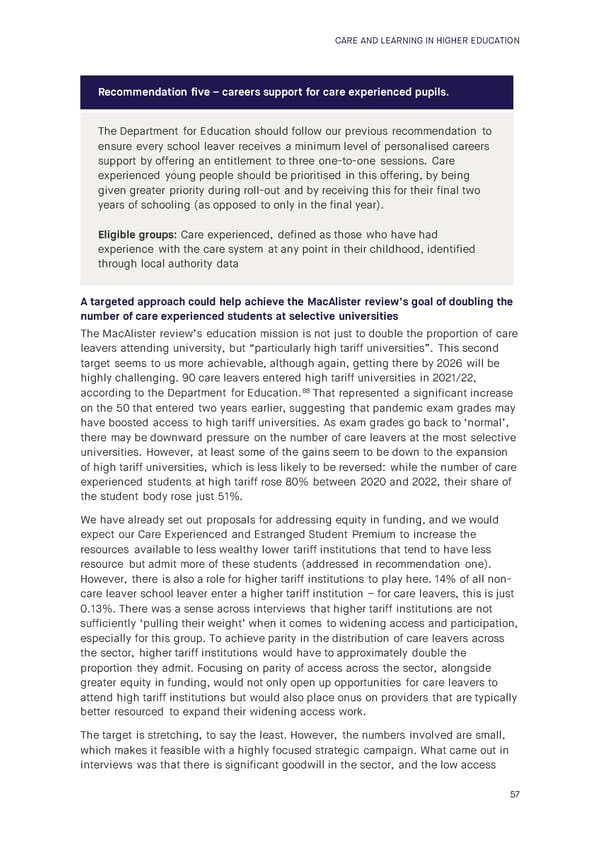CARE AND LEARNING IN HIGHER EDUCATION Recommendation five – careers support for care experienced pupils. The Department for Education should follow our previous recommendation to ensure every school leaver receives a minimum level of personalised careers support by offering an entitlement to three one-to-one sessions. Care experienced young people should be prioritised in this offering, by being given greater priority during roll-out and by receiving this for their final two years of schooling (as opposed to only in the final year). Eligible groups: Care experienced, defined as those who have had experience with the care system at any point in their childhood, identified through local authority data A targeted approach could help achieve the MacAlister review’s goal of doubling the number of care experienced students at selective universities The MacAlister review’s education mission is not just to double the proportion of care leavers attending university, but “particularly high tariff universities”. This second target seems to us more achievable, although again, getting there by 2026 will be highly challenging. 90 care leavers entered high tariff universities in 2021/22, according to the Department for Education.88 That represented a significant increase on the 50 that entered two years earlier, suggesting that pandemic exam grades may have boosted access to high tariff universities. As exam grades go back to ‘normal’, there may be downward pressure on the number of care leavers at the most selective universities. However, at least some of the gains seem to be down to the expansion of high tariff universities, which is less likely to be reversed: while the number of care experienced students at high tariff rose 80% between 2020 and 2022, their share of the student body rose just 51%. We have already set out proposals for addressing equity in funding, and we would expect our Care Experienced and Estranged Student Premium to increase the resources available to less wealthy lower tariff institutions that tend to have less resource but admit more of these students (addressed in recommendation one). However, there is also a role for higher tariff institutions to play here. 14% of all non- care leaver school leaver enter a higher tariff institution – for care leavers, this is just 0.13%. There was a sense across interviews that higher tariff institutions are not sufficiently ‘pulling their weight’ when it comes to widening access and participation, especially for this group. To achieve parity in the distribution of care leavers across the sector, higher tariff institutions would have to approximately double the proportion they admit. Focusing on parity of access across the sector, alongside greater equity in funding, would not only open up opportunities for care leavers to attend high tariff institutions but would also place onus on providers that are typically better resourced to expand their widening access work. The target is stretching, to say the least. However, the numbers involved are small, which makes it feasible with a highly focused strategic campaign. What came out in interviews was that there is significant goodwill in the sector, and the low access 57
 Care and Learning in Higher Education Page 57 Page 59
Care and Learning in Higher Education Page 57 Page 59